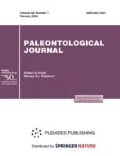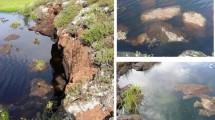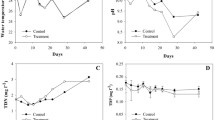Abstract
The work continues the series of long-term studies of the microbial diversity of soda lakes and concerns the problem of anaerobic decomposition of proteins. The physiology of new proteolytic bacteria has been investigated. The lytic effect of the alkaliphilic anaerobe Proteinivorax tanatarense on other members of community, primarily cyanobacteria, has been demonstrated. P. tanatarense proved to be a saprotrophic satellite regulating the number of cyanobacteria under night conditions. The directed effects of P. tanatarense on phototrophic and chemotrophic Gram-negative microorganisms were demonstrated as well as the absence of its effect on any Gram-positive microorganisms. Such specialization of proteolytic agent could be implemented in cyanobacterial communities of the past.



Similar content being viewed by others
REFERENCES
Alazard, D., Badillo, C., Fardeau, M.L., Cayol, J.L., Thomas, P., Roldan, T., Tholozan, J.L., and Ollivier, B., Tindallia texcoconensis sp. nov., a new haloalkaliphilic bacterium isolated from Lake Texcoco, Mexico, Extremophiles, 2007, vol. 11, pp. 33–39.
Boltyanskaya, Yu.V., Antipov, A.N., Kolganova, T.V., Lysenko, A.M., Kostrikina, N.A., and Zhilina, T.N., Halomonas campisalis, an obligatorily alkaliphilic, nitrous oxide-reducing denitrifier with a Mo-cofactor-lacking nitrate reductase, Mikrobiologiya, 2004, vol. 73, no. 3, pp. 326–334.
Dubinin, A.V., Gerasimenko, L.M., and Zavarzin, G.A., Ecophysiology and species diversity of cyanobacteria in Lake Magadi, Mikrobiologiya, 1995, vol. 64, no. 6, pp. 845–849.
Duckworth, A.W., Grant, W.D., Jones, B.E., and van Steenbergen, R., Phylogenetic diversity of soda lake alkaliphiles, FEMS Microbiol. Ecol., 1996, vol. 19, pp. 181–191.
Gerasimenko, L.M., Dubinin, A.V., and Zavarzin, G.A., Alkaliphilic cyanobacteria from soda lakes of Tuva and their ecophysiology, Mikrobiologiya, 1996, vol. 65, no. 6, pp. 736–740.
Grant, W.D. and Jones, B.E., Bacteria archaea and viruses of soda lakes, in Soda lakes of East Africa, Schagerl, M., Ed., Springer, 2016.
Grant, W.D., Mwatha, W.E., and Jones, B.E., Alkaliphiles: Ecology, diversity and applications, FEMS Microbiol. Rev., 1990, vol. 75, pp. 255–270.
Isachenko, B.L., Chloride, sulphatic, and soda lakes of the Kulunda Steppe and biogenic processes in them, in B.L. Isachenko. Izbrannye trudy (B.L. Isachenko: Selected Works), Moscow–Leningrad: Akad. Nauk SSSR, 1951, pp. 143–162.
Kevbrin, V., Boltynskaya, Y., Zhilina, T., Kolganova, T., Lavrentjeva, E., and Kuznetsov, B., Proteinivorax tanatarense gen. nov., sp. nov., an anaerobic, haloalkaliphilic, proteolytic bacterium isolated from a decaying algal bloom, and proposal of Proteinivoraceae fam. nov, Extremophiles, 2013, vol. 17, pp. 747–756.
Kevbrin, V.V., Zhilina, T.N., Rainey, F.A., and Zavarzin, G.A., Tindallia magadii gen. nov., sp. nov.: An alkaliphilic anaerobic ammonifier from soda lake deposits, Curr. Microbiol., 1998, vol. 37, pp. 94–100.
Makarov, S.Z., Materialy k fiziko-khimicheskomu izucheniyu solyanykh ozer Kulundinskoi stepi. Kulundinskaya ekspeditsiya Akademii nauk SSSR 1931–1932 gg. (Material of Physical and Chemical Analysis of Hydrochloric Lakes of the Kulunda Steppe: Kulunda Expedition of the Academy of Sciences of the USSR in 1931–1932), Moscow–Leningrad: Akad. Nauk SSSR, 1935.
Melack, J.M. and Kilham, P., Photosynthetic rates of phytoplankton in East African alkaline, saline lakes, Limnol. Oceanogr., 1974, vol. 19, pp. 743–755.
Pikuta, E.V., Hoover, R.B., Bey, A.K., Marsic, D., Detkova, E.N., Whitman, W.B., and Krader, P., Tindallia californiensis sp. nov., a new anaerobic, haloalkaliphilic, spore-forming acetogen isolated from Mono Lake in California, Extremophiles, 2003, vol. 7, pp. 327–334.
Samylina, O.S., Gerasimenko, L.M., and Shadrin, N.V., Comparative characteristics of phototrophic communities in mineral lakes of Crimea (Ukraine) and the Altai Region (Russia), Al’gologiya, 2010, vol. 20, no. 2, pp. 192–209.
Samylina, O.S., Sapozhnikov, F.V., Gainanova, O.Yu., Ryabova, A.V., Nikitin, M.A., and Sorokin, D.Yu., Algobacterial communities of the Kulunda steppe (Altai Region, Russia) soda lakes, Mikrobiologiya, 2014, vol. 83, no. 6, pp. 849–860.
Shapovalova, A.A., Khijniak, T.V., Tourova, T.P., Muyzer, G., and Sorokin, D.Y., Heterotrophic denitrification at extremely high salt and pH by haloalkaliphilic Gammaproteobacteria from hypersaline soda lakes, Extremophiles, 2008, vol. 12, pp. 619–625.
Sorokin, D.Y., Banciu, H.L., and Muyzer, G., Functional microbiology of soda lakes, Curr. Opin. in Microbiol., 2015, vol. 25, pp. 88–96.
Sorokin, D.Y., Tourova, T.P., Panteleeva, A.N., Kaparullina, E.N., and Muyzer, G., Anaerobic utilization of pectinous substrates at extremely haloalkaline conditions by Natranaerovirga pectinivora gen. nov., sp. nov., and Natranaerovirga hydrolytica sp. nov., isolated from hypersaline soda lakes, Extremophiles, 2012, vol. 16, pp. 307–315.
Takai, K., Moser, D.P., Onstott, T.C., Spoelstra, N., Pfiffner, S.M., Dohnalkova, A., and Fredrickson, J.K., Alkaliphilus transvaalensis gen. nov., sp. nov., an extremely alkaliphilic bacterium isolated from a deep South African gold mine, Extremophiles, 2001, vol. 51, pp. 1245–1256.
Zavarzin, G.A., Epicontinental soda water bodies as presumable relict biotopes for the development of terrestrial biota, Mikrobiologiya, 1993, vol. 62, no. 5, pp. 789–800.
Zavarzin, G.A., Formation of soda conditions as a global process, Tr. Inst. Mikrobiol. Ross. Akad. Nauk, 2007, vol. 14 (Alkaliphilic Microbic Assemblages, Gal’chenko, V.F., Ed.), pp. 8–57.
Zavarzin, G.A., First ecosystems of the Earth, in Problemy proiskhozhdeniya zhizni (Problems of the Origin of Life), Rozanov, A.Yu., Lopatin, A.V., and Snytnikov, S.N., Eds., Moscow: Paleontol. Inst. Ross. Akad. Nauk, 2009, pp. 230–244.
Zavarzin, G.A., Zhilina, T.N., and Kevbrin, V.V., Alkaliphilic microbial community and its functional diversity, Mikrobiologiya, 1999, vol. 68, no. 5, pp. 503–521.
Zavarzin, G.A., Zhilina, T.N., and Pikuta, E.V., Secondary anaerobes in haloalkaliphilic lake communities of Tuva, Mikrobiologiya, 1996, vol. 65, no. 4, pp. 480–486.
Zhilina, T.N., Chemotrophic anaerobes of microbial communities of soda lakes, Tr. Inst. Mikrobiol. Ross. Akad. Nauk, 2007, vol. 14 (Alkaliphilic Microbic Assemblages, Gal’chenko, V.F., Ed.), pp. 158–224.
Zhilina, T.N., Detkova, E.N., Rainey, F.A., Osipov, G.A., Lysenko, A.M., Kostrikina, N.A., and Zavarzin, G.A., Natronoincola histidinovorans gen. nov., sp. nov., an extremely haloalkaliphilic, homoacetic bacterium: A new member of Haloanaerobiales, Curr. Microbiol., 1998. vol. 32, pp. 320–326.
Zhilina, T.N., Kevbrin, V.V., Turova, T.P., Lysenko, A.M., Kostrikina, N.A., and Zavarzin, G.A., Clostridium alkalicellum sp. nov., an obligately alkaliphilic cellulolytic from a soda lake in the Baikal Region, Mikrobiologiya, 2005, vol. 74, no. 5, pp. 642–653.
Zhilina, T.N. and Zavarzin, G.A., Alkaliphilic anaerobic community at pH 10, Curr. Microbiol., 1994, vol. 29, pp. 109–112.
Zhilina, T.N., Zavarzina, D.G., Kolganova, T.V., Lysenko, A.M., and Turova, T.P., New alkaliphilic peptide fermenting and Fe(III) regenerating bacteria Alkaliphilus peptidofermentans sp. nov. from soda lake, Mikrobiologiya, 2009a, vol. 78, no. 4, pp. 496–505.
Zhilina, T.N., Zavarzina, D.G., Osipov, G.A., Kostrikina, N.A., and Turova, T.P., Natronincola ferrireducens sp. nov. and Natronincola peptidovorans sp. nov., new anaerobic alkaliphilic peptide lysing and iron-reducing bacteria from soda lake, Mikrobiologiya, 2009b, vol. 78, no. 4, pp. 506–518.
ACKNOWLEDGMENTS
The study was partially supported by Basic Research Program No 17, Subprogram 2 of the Russian Academy of Sciences “Evolution of the Organic World and Planetary Processes”, a grant from the Russian Foundation for Basic Research No. 18-04-00236 “Degradation of nitrogen-containing components of a bacterial cell by alkaliphilic microorganisms of soda lakes”, and by a state assignment No. 0104-2018-0030.
Author information
Authors and Affiliations
Corresponding authors
Additional information
Translated by E. Makeeva
Rights and permissions
About this article
Cite this article
Boltyanskaya, Y.V., Kevbrin, V.V. Laboratory Simulation of “Proteolytic Bacterium–Cyanobacterium” Interaction in Alkaliphilic Microbial Community. Paleontol. J. 52, 1179–1185 (2018). https://doi.org/10.1134/S0031030118100064
Received:
Published:
Issue Date:
DOI: https://doi.org/10.1134/S0031030118100064




